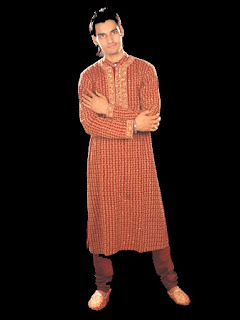Fashion refers to glamour, beauty and style. Though the term may encompass a lot more, its general usage is for appearance of
clothing and it varies constantly with time and culture.
Though fashion hubs have been western cities like Paris, Milan, London and New York. Now, India has also emerged powerful on fashion scene.
Since, India has a rich and varied
textile heritage with each region of India having its own unique native costume and traditional attire, fashion in India becomes dyanamic and vibrant enough to assimilate international fashion trends too. It is reflected by the young and glamorous, in the cosmopolitan metros of India. As an industry it is nascent but its future is enormous and colorful.
Fashion in India has become a growing industry with international events, Indian beauty queens in International events such as the Miss World and Miss Universe contests and Indian Fashion designers cropping up in India.
Fashion in India covers a whole range of clothing from ornate clothes designed for wedding ceremonies to prêt lines, sports wear and casual wear. Traditional Indian techniques of embroidery such as chikhan, crewel and zardosi, and traditional weaves and fabrics have been used by Indian designers to create Indo-western clothing in a fusion of the best of East and West. The fusion of it and Indian Fashion accessories such as bindis (red dots worn on the forehead), mehendi (designs made by applying henna to the palms of the hands and other parts of the body) and bangles, have gained international popularity, after being worn by fashion icons like the pop singers Madonna and Gwen Stephani.
 Regional Fashion Trends in India
Regional Fashion Trends in India
Traditional costumes in India vary widely depending on the climate and natural fibres grown in a region.

In the cold
northern state of Jammu and Kashmir, people wear a thick loose shirt called a phiran to keep them warm. In the tropical warmth of south India men wear a sarong like garment called the mundu, while women drape 5 meters of cloth around their bodies in the graceful folds of the

saree. Sarees are woven in silk, cotton and artificial fibres. Kanjivaram, Mysore, Paithani, Pochampalli, Jamdani, Balucheri, Benarasi, Sambalpuri, Bandhini are some varieties of beautiful sarees from different regions of India.
In the
dry regions of Rajasthan and Gujarat men wrap and twist a length of cloth in the form of a dhoti around their lower limbs and a shirt-like kurta above. Colorful turbans complete the picture.
In the northeastern regions the tribal communities such as Khasis, Nagas, Mizos,

Manipuris and Arunachalis wear colorful woven sarong-like clothing and woven shawls that represent the identity of each tribal group.
In
urban India the salwar kameez and the churidar kameez, are commonly work by women and the saree is worn on formal occasions. Men wear kurtas and pajamas, or a sherwani for formal wear.
Western wear such as shirts and trousers are commonly worn by men across India. Jeans, T-shirts, capris, bermudas and various kinds of casual clothing are worn by the young and the young at heart, who are the trendsetters of
fashion in India.
Fashion in India continues to evolve and find new horizons.









![Reblog this post [with Zemanta]](http://img.zemanta.com/reblog_e.png?x-id=eb349957-f0d1-4dc5-9ded-ef1b1b437ad0)